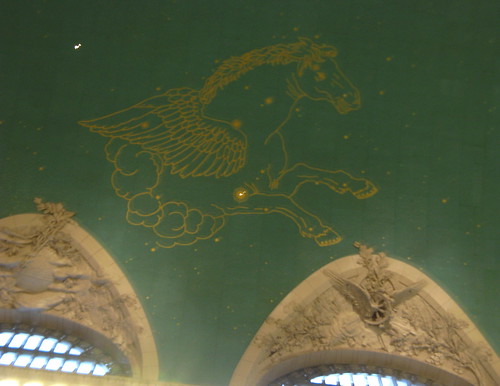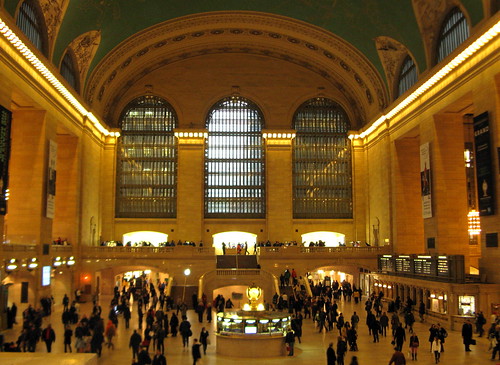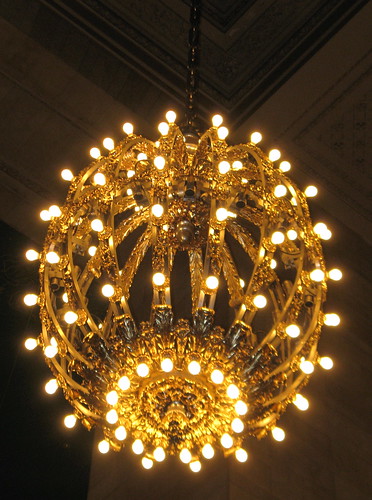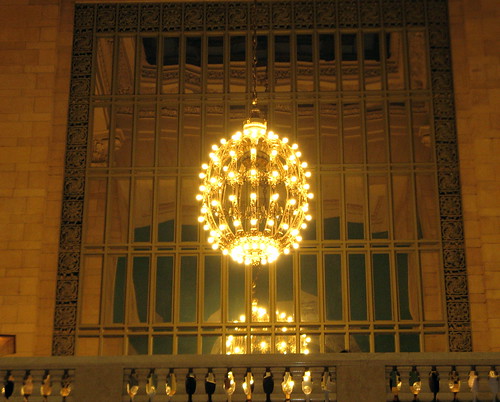For many, it may be hard to grasp that where Grand Central Terminal stands today we could have had massive office towers and no magnificent train station. But it’s important to never forget. In the 1950s and 1960s on separate occasions, developers and Penn Central Railroad launched plans that would have destroyed Grand Central. Ultimately, however, after many people – prominently among them, leading architects and Jacqueline Kennedy Onassis – organized to oppose such plans, and the New York Landmarks Preservation Commission pursued legal battles about its landmarking powers, those who sought to save Grand Central Terminal won. What has this meant to New York City?
Consider that before the threats occurred to Grand Central, another campaign to save a historic and stunning civic structure, Pennsylvania Station, had failed. The then-declining Pennsylvania Railroad began to demolish the station in 1963, a destruction that took three years. After that tragic loss, the City of New York established the Landmarks Preservation Commission. Today, when you walk around the current Pennsylvania Station and nearby blocks, you find an area lacking soul and a train station that feels like a poorly planned, crowded suburban mall where people happen to catch trains. At Grand Central, the opposite has occurred.
This coming week, Grand Central turns 100 years old. The terminal opened on Feb. 2, 1913. Tomorrow, Feb. 1, MTA Metro-North Railroad, which operates Grand Central Terminal, and other entities are throwing a huge 100th birthday party, and they will follow up with events and exhibits in 2013.
Today, Grand Central is a vital link through which some 700,000 people travel each day on trains and subways – somehow, in the station’s efficiently and elegantly planned waiting rooms and concourse, not bumping into each other. Moreover, it’s one of the world’s most-visited and loved tourist destinations as well as a place that New Yorkers continue to thoroughly enjoy and prize.
That we have the beauty, function, and rich experience of Grand Central today is not only a testament to those who fought for it and continue to build on and maintain its heritage, but to the genius of its original architects. The architectural firm of Reed & Stern did the overall planning, while Warren & Wetmore designed and executed the spectacular Beaux Arts style and details. Credit the MTA Metro-North Railroad, too, for undertaking a major makeover and restoration in the 1990s to rehabilitate a long-decaying terminal.
To appreciate why Grand Central’s survival matters, let’s adapt a premise from the movie It’s a Wonderful Life. What if Grand Central Terminal had not been saved – if this splendid historic building had been, in effect, killed by demolishing all or a significant part of it? Think about the difference it would make to New York City and the world if Grand Central hadn’t survived and wasn’t here anymore. How many grandparents would have missed out on showing their grandkids the Sky Ceiling in the Main Concourse? How many folks would never have experienced the “Whispering Gallery”? How about the woman who savored some slices of Tuscan salami made with fennel before heading back to her Midwest home? What different experiences would commuters departing and arriving on Metro-North trains have had all of these years – almost certainly not having that expansive, welcoming concourse before dashing out onto the city’s hectic streets?
Many people who catch trains, work, dine, have cocktails, shop, visit, tour, walk the concourses and corridors, or attend events at Grand Central have their own significant places, favorite nooks or features, and memories of Grand Central they could list.
As this gem of a train station marks its first century, Mindfulwalker.com takes a look at 10 places or treasures to appreciate on a stroll of Grand Central, five in this photo essay and another five to follow in a post soon. In another column, Mindfulwalker.com plans to focus on a proposal to rezone East Midtown that, in the view of New York’s Municipal Art Society, could radically change the skyline near Grand Central and alter nearby iconic streets.
Part I focuses on some treasures of the Main Concourse.
Sky Ceiling
It’s hard to understand how anyone could walk through the Main Concourse without looking up and admiring – even for brief moments on a commute – the painted Sky Ceiling (but it happens all the time). People from all over the world come to see this unique rendering of the heavens. The sky is a deep green-blue, and the constellations are outlined in gold leaf. The ceiling, 125 feet across and hung from steel trusses, contains 2,500 gold stars. Sixty are LED lights to highlight the constellations of a Mediterranean sky for the October to March zodiac. Architect Whitney Warren and French artist Paul César Helleu collaborated to conceive of and create the ceiling.
Picture yourself arriving in New York City at Grand Central, in the early 20th century, when trains were the main means of long-distance travel. This fine interior space and its sky ceiling would greet you as you emerged from the train platforms into the concourse. However, the starry ceiling, though a treasure, fell upon hard times as years went by – just as the rest of the terminal did – when long-distance train use declined precipitously. Over time, the ceiling became covered in a thick layer of grime. Ultimately, tests found it was primarily tar and nicotine from tobacco smoke. (Non-smoking keeps not only our bodies but our places healthier.)
Grand Central’s, and the astronomical ceiling’s, fortunes were resuscitated when Metro-North embarked on the ambitious restoration and rebuilding project in the 1990s. Besides constructing an east staircase, opening up passageways, transforming the Waiting Room into an exhibition hall, and adding retail and dining space, Metro-North had the ceiling cleaned by hand, revealing its glory and luster. By 1998, the painted stars and constellations could be seen again.
Many guides and articles point out that the sky is backward and discuss why this is so. (This talk has been going on for a century: The New York Times reported on March 23, 1913, that a “a commuter from New Rochelle who has dabbled in astronomy” made the discovery and had pointed out “wrathfully” in a letter that “west is east and east is west.”) While it’s valuable to understand the difference and see if the 8-year-old budding astronomer in the family picks up on it, the ceiling is wondrous all the same. When I walk under it, I feel energized, almost ennobled by the sight of the Sky Ceiling. At times, the stars and constellations seem in motion. It brings to mind the greater universe and beckons to the worlds beyond.
Grand Central’s Main Concourse
The Information Booth Clock
Because the Main Concourse floor is wide-open and possesses minimal interruption, the clock atop the Information Booth in the center of this commanding space stands out. That’s as it should be. It’s a marvel of beauty, elegance, and utility. Take a moment when you are rushing by to really look at it: Fashioned of brass for Grand Central when the terminal opened, the clock sits on an exquisitely detailed pedestal. It has four faces of opalescent glass, and the lighting behind the faces given it a warm, cream-colored glow. At the very top is a brass acorn, part of the acorns and oak leaves that railroad baron Cornelius Vanderbilt had chosen for his family’s symbols out of the old saying, “from an acorn a mighty oak shall grow.”
The Connecticut-based Seth Thomas Clock Co. was actually turning 100 years old when the company manufactured this clock for Grand Central’s 1913 opening, according to ClockHistory.com. While it hearkens to the early 20th century, its timekeeping is far advanced from that era and is amazingly accurate. It’s set every second by the atomic block at the U.S. Naval Observatory at Bethesda, Md., and thus is accurate to within 1 second every 20 billion years.
We can appreciate the clock because it’s one of the most recognized icons in the world or because, as so many articles and guides mention, it’s the location where countless people say, “Meet me at the clock.” We can relish that it has been in many movies, such as Alfred Hitchcock’s North By Northwest, The Fisher King, The Godfather, Arthur, The Cotton Club, and the 1942 film that started its film career, Grand Central Murder.
Yet I love the clock’s intangible qualities. It commands attention without being big and garish, like too many of today’s visual icons. Whether heading rapidly for a train, meeting someone, or at Grand Central to dine or hang out, I find it calming, with its lovely clock face that seems to say “you have time” in ways that a digital face never can. Finally, it’s just a gorgeous timepiece.
Beaux Arts Chandeliers
The Beaux Arts chandeliers demonstrate how those who built Grand Central a century ago wanted train travelers to feel an experience of grand luxury. The 10 melon-shaped chandeliers framing the Main Concourse – five on the north balcony and five to the south toward Vanderbilt Hall – possess a timeless simplicity, even with their ornate detailing. While people have written hundreds of articles about Grand Central’s secrets and delights, these nickel and gold-plated chandeliers, 11 feet wide by 18 feet high, are one of the most overlooked features. Their shimmer and reflections help produce a sparkle within the concourse.
Like other elements of Grand Central, the chandeliers evoke a century ago but with an up-to-date twist. The chandeliers originally contained bare incandescent light bulbs, which were a commercial novelty in 1913, according to MTA Metro-North. This was part of showcasing the station’s embrace of electricity. However, the 110 bulbs on each chandelier use much more energy than the newer efficient compact fluorescent light bulbs. In 2009, electricians replaced thousands of bulbs in Grand Central with the fluorescent ones, including hundreds on the chandeliers, and MTA Metro-North projected savings of $200,000 per year. So the chandeliers retain their historic splendor and exhibit smart technology.
Light and Reflections
People have waltzed on the floors of the Main Concourse, and it’s no wonder. The concourse is spacious, a gigantic jewel-like box in which one might be a graceful character within. Its light and reflections, changing throughout the day and night, engender awe and, at times, a sort of magical feeling.
The concourse’s light is even more precious considering that for decades a lot of it was lost for a variety of reasons. Many know that in World War II the owners of Grand Central blackened the skylight windows as part of New York City’s blackout program. The windows remained blackened for decades beyond any need to keep them that way, and the last of this blackout paint was not removed until 2007.
The concourse, however, was otherwise blighted for decades due to billboard advertising, additions that cramped the space, and neglect. In the 1990s restoration and subsequently, Metro-North opened up passageways, cleared the concourse’s clutter, and cleaned the terminal inside and out. As the New York Times detailed at the time, the railroad transformed the walkway into the concourse by putting in an open balustrade and by getting rid of office space that was above the converging ramps that lead to the Oyster Bar and lower concourse, thus flooding the ramps with light. Other transformations have meant that today the Main Concourse and its adjacent balconies are bathed in light far more.
Arched Windows
A classic view of Grand Central shows shafts of light coming through the giant arched windows onto the Main Concourse floor. Talk about heavenly design. These windows, in cast iron frames and bordered by fluted classical columns, are 60 feet tall and double-glazed. As the Grand Central audio tour points out, they are more properly “tubes” of glass rather than walls. Each set, on the east and west side, are double windows with wide, enclosed catwalks, which architect Warren designed to connect with adjoining buildings.
Light penetrates the concourse from these windows. Because the windows are elevated, the way they cast light also imparts a sense of roominess and grace in walking the concourse, akin to moving about in a grand performance hall or cathedral.
A monumental building such as Grand Central can retain its greatness if those who tend such a place adapt it flexibly to succeeding generations and needs while carefully remaining the stewards of its priceless historic nature and features, all the while improving on its original purpose. This can be celebrated in 2013. Within Grand Central’s centennial celebration is recognition that it may not have reached its 100th birthday at all. Without the will and persistence of many people decades ago, Grand Central may have become, the way Pennsylvania Station has in the decades since its destruction, the station we see only in pictures and remember in special but ever more distant memories.
Grand Central Terminal, 100 years and counting.
Appreciation and Celebration
Grand Central possesses countless cherished features and treasures, such as the ones above.
Part II starts at the Grand Concourse and heads into passageways off of the concourse to find more great things:
Mindful Walker: Grand Central’s Gems at 100, Part II
The 100th birthday celebration tomorrow, Feb. 1, is an all-day affair with music and dance performances, notable speakers, special offers, and more. Check out:
Grand Central, Grand Centennial Celebration – Feb. 1
Grand Central will have additional events, exhibits at the New York Transit Museum, multimedia experiences, and other programs throughout the late winter and spring to mark the centennial:
Do you have special memories and particular things you cherish about Grand Central? If so, share them here.
Correction: The initial version of this article noted incorrectly that the arched windows were blackened out for a long time after World War II. However, the skylight windows, along the north and south sides of the Main Concourse, contained blackout paint – the last of which the operators of Grand Central did not remove until several years ago. Thank you to Moshe Feder for sending this corrective information to Mindfulwalker.com.









Susan, thanks for another wonderful article on a truly magical New York landmark!
Rachel,
Thank you! So happy you enjoyed it. It is a magical landmark, isn’t it? We’re very lucky.
Enjoy your day!
Susan
Excellent article.
Thanks and congratulations for correctly describing the information booth’s clock’s faces as opalescent glass. Too many sites on the Web spread the canard that they are made of actual opal, a ridiculous misunderstanding based on their actually being “opal glass,” also known as “milk glass.”
I would like to offer a correction however. I’m not sure if the arched windows were blacked out during WW II, but as someone who’s been visiting GCT since the 50s, I can assure you that they were not blacked out then or since. What was blacked out until just a few years ago were the skylights along the north and south sides of the main concourse. (The north ones are over the balcony there, the south ones are over the Oyster Bar ramps to the lower level.)
Thanks, and keep up the good work.
Susan – I fell in love with Grand Central Station on my only visit there. Having seen it in movies and in photos over the years, I had the distinct feeling that I was finally meeting an old friend in person for the first time. Plus, as the daughter of a railroader, I have a great affection for all things “train”. Thanks for this lovely piece about such a “grand” place!
Nita,
I love your retelling of your first encounter with Grand Central and your feeling that this amazing place was like “meeting an old friend.” Wow. Gladdens me even more that it meant something beyond because your father was a railroader. The railroads have their own particular romance and heritage, which I fear gets lost today. Thankfully, Grand Central Terminal is a very special place that keeps this alive.
Gratefully,
Susan
You saw so much more in Grand Central Station than I ever did as I went hurrying through it running to catch trains. You have provided me with the incentive to go back and take a much closer look next time I am in the City. Continue your mindful walking. I enjoy each and every one of your journeys and have become more mindful as a result. Thank you for your continued insights.
Dear Barbara,
I’m delighted that this has sparked a desire to come back to take a closer look at Grand Central. Great! I’m afraid all of our deadlines and demands have many of us rushing through Grand Central, so you were in lots of company, I’m sure.
I feel honored by your encouragement, and the lovely way you express it especially — to continue walking mindfully. I’m happy that this has brought you more enjoyment and a sense of becoming more mindful. I couldn’t ask for anything more! And I have to say: It makes me more mindful in my own rushing!
Gratefully,
Susan
I’m so glad you mentioned the catwalk that connects buildings and goes between the soaring windows/tubes of glass. I saw someone going by once and have always wondered how I could walk the walk but guess it’s just an ‘in-house’ thing? (Certainly could never find a sidewalk from outside.)
Gary,
Thanks for your comment, and yes, I bet many people wonder how they can “walk the walk” of Grand Central’s catwalks. The catwalk areas are employee-access only, as confirmed by an MTA Metro-North Railroad spokeswoman today.
However, I know that some special tours of Grand Central Terminal have taken members of the public to the catwalk area, and you may want to watch for one of these tours. In fact, your comment came after such an opportunity occurred there last week. The Historic Districts Council had a “Secret Lives Tour” of Grand Central on Thursday, Nov 21. During that three-hour walk of passageways, secret corners, and intriguing cubbyholes, those on the tour were able to go on the topmost catwalk (not one of the center ones). This tour may be given in the future — the group offered it last year and this year — so if interested, you may want to keep an eye on the HDC’s Web site in 2014.
I’ve seen photos of the main hall that people have taken from a catwalk — incredible!
Susan